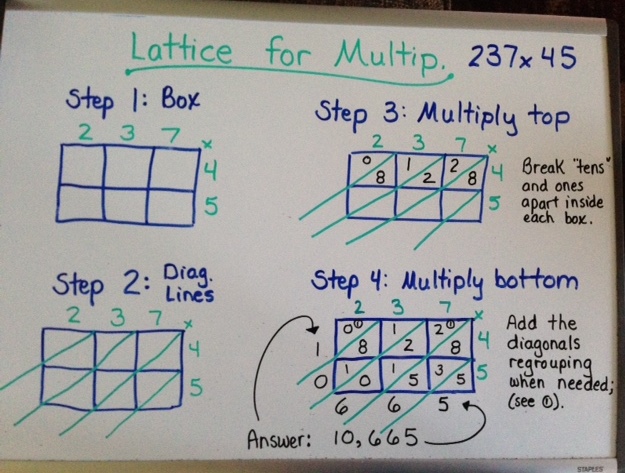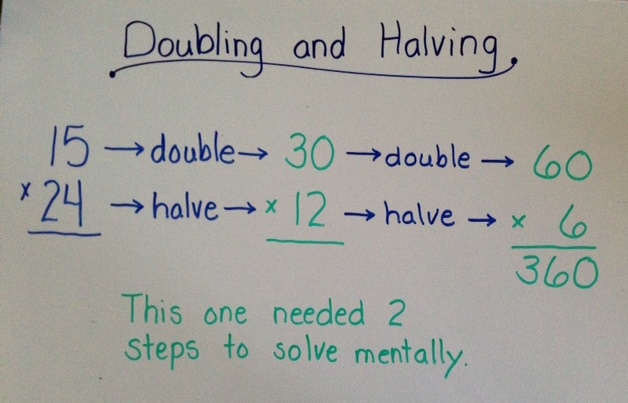by C. Elkins, OK Math and Reading Lady

Doubling and . . .
I hope you have had a chance to look at Parts 1, 2, and 3 of my multiplication strategy posts. These strategies are especially helpful with 3rd – 5th grade students (and beyond). I have been reading a book by Dr. Nicki Newton called “Guided Math in Action.” She discusses five components to being mathematically proficient. One of them is strategic competence. What is strategic competence? The National Research Council defines it as “the ability to formulate mathematical problems, represent them, and solve them.” The first process std. in Common Core (Make Sense of Problems and Persevere in Solving Them) emphasizes strategic competence in this way: “they try special cases and simpler

Halving Multip. Strategy
forms of the original problem in order to gain insight into its solution, . . . students check their answers to problems using a different method, and they continually ask themselves, Does this make sense? . . . and, they can understand the approaches of others to solving complex problems and identify correspondences between different approaches.”
With all of that said, I would like to show two other multiplication strategies: 1) Doubling and Halving, and 2) the Lattice Method. All of the strategies picture boards I have shown are available on this free PDF (It’s 10 pages): Multiplication Strategies PDF
Doubling and Halving
Doubling and halving is supported by the associative property. It also enables the student to use mental math strategies. Here is an example: Original Problem: 25 x 12. When changed to 50 x 6, I can solve it mentally which equals 300. From what I have researched and applied, here are some tips:
- Use when a problem has one even and one odd factor (or two even factors). It won’t work with 2 odd factors because you can’t break an odd number in half and still get a whole number.
- Double the odd factor and halve the even factor. Do this 1-3 times until you get two factors which can be multiplied mentally.
- Most useful when the odd factor has a 5 in the one’s place (because 5 doubled is 10, so the result will be a multiple of 10 which can usually be taken care of mentally).
How is the above problem connected to the associative property?
- Think of 25 x12 as 25 x (2 x 6).
- If I apply the associative property, I get (25 x 2) x 6 = 50 x 6 = 300.
- I can also go another step further and show that 50 x 6 = 50 x (2 x 3) = (50 x 2) x 3 = 100 x 3 = 300.
- Here is another one: Think of 15 x 24 as 15 x (2 x 12) = (15 x 2) x 12 = 30 x 12 = 360.
- See my pictures below of how that looks in array form with the problems 3 x 4 and 5 x 12.
- 3 x 4 = 3 x (2 x 2) which equals (3 x 2) x 2
- 5 x 12 = 5 x (2 x 6) which equals (5 x 2) x 6
When teaching this strategy, I allow students to figure out which type of problems this best applies to rather than giving them the hints above. They will hopefully discover that some problems can be done incredibly fast this way, while others not so much. The success of using this strategy is knowing which types of problems it works quickly with.
I also don’t really go into too much detail about the associative property method (above) with students. I did that to show you the logic behind the method. Remember these are not “tricks.” There is always a mathematical reason behind the strategy, no tricks involved – just understanding. I often show the array model so students can see its the same problem, just “rearranged.” I mostly teach them how to double a 2-digit number mentally, if they don’t already know it. This absolutely builds on what students should have practiced since first grade (their doubles addition facts) and in second and third grades (multiplying x 2). Click here for a free double / half matching activity. There are some blank templates at the end so you can create your own. Idea: Hand them out to students and they have to find their double / half match. Or use them to teach the concept. 
- Double the ones.
- Double the tens.
- Add them together..
I teach them how to halve an even number, which also relates to division and fractions. Click here for another free activity called Double This Double That. The first page has multiple copies of the directions which can go on the front of the activity envelopes. Then the other pages have the cards. Students must find all 4 cards that go together.
- Halve the ones.
- Halve the tens.
- Add them together.
Try these examples. 35 x 12; 5 x 42; 45 x 4 (See solutions at the end of this post.)
Multiplying by 4 (Double twice strategy): When multiplying by 4 just double the other factor twice. Example: 8 x 4 = 8 x 2 x 2 = 16 x 2 = 32. How about 42 x 4. Same as 42 x 2 x 2 = 84 x 2 = 168. What’s the math behind it? Knowing that 4 = 2 x 2, I can once again refer to the associative property: 42 x 4 = 42 x (2 x 2) = (42 x 2) x 2.
Multiplying by 8 (Double 3 times): When multiplying by 8, double the other factor three times (because 8 = 2 x 2 x 2). Example: 13 x 8 = 13 x 2 x 2 x 2. 13 x 2 = 26; 26 x 2 = 52; 52 x 2 = 104.
This applies to division in reverse: When dividing by 4, halve the dividend twice. When dividing by 8, halve the dividend 3 times.
Lattice Method
I will admit I am not a big fan of the lattice method for a couple of reasons. However, there are two reasons I do support its use, which I will explain later. Cons: If you mess up a step, you get a wrong answer. There are so many lines involved that some students have a hard time following them all. Individual digits are multiplied (rather than applying an understanding of place value) so there is almost no concept of the magnitude of the expected answer.
Now, here are the 2 reasons I do support its use. One is that this method was presented on test questions through the Alpha Plus organization in some districts in Oklahoma, so students needed to learn it. Secondly, it may increase accuracy when multiplying larger numbers such as those with 2 or more digits.
Answers from above
35 x 12 can be solved as 70 x 6 = 420
5 x 42 can be solved as 10 x 21 = 210
45 x 4 can be solved as 90 x 2 = 180
As always, I appreciate when you share your experience with these strategies, or your willingness to try something new. Have a great week!



